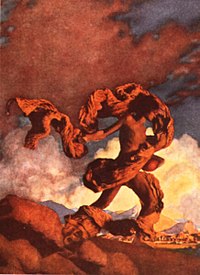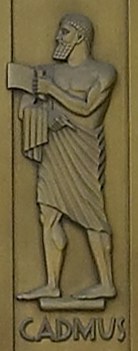Cadmus
Cadmus, Kadmus or Kadmos (Greek: Κάδμος), in Greek and Phoenician mythologies, was a Phoenician prince,[1] son of Agenor and the brother of Phoenix, Cilix and Europa.[2] Cadmus founded the Greek city of Thebes, with its acropolis originally named Cadmeia in his honor, and most significantly he is generally accredited with the introduction of the Phoenician alphabet to the Greek. The Greek adopted the Phoenician alphabet and used it to form their Greek alphabet. There are however 'recent' controversial theories, mainly Greek, to discredit Cadmus in the founding of Thebes or to the history of the Greek alphabet. These theories mainly try to set Cadmus' role in the "founding myth" of Thebes, placing him him in the Mycenaean age, to claim that the alphabet arrived in Greece centuries afterwards,[3] during the eighth century. Even Greek of Classical times credit Cadmus with the introduction of the (Phoenician)alphabet, phoinikeia grammata.[4] Herodotus who gives this account estimates that Cadmus lived sixteen hundred years before his time, or around 2000 BC.[5]
In the modern country of Lebanon today (ancient Phoenicia), Cadmus is a commonly used male name and the historical exploits of Cadmus are revered and taught in schools and universities. Many Lebanese cultural organizations have adopted his name, and annual book festivals are also named after him in his honor. According to Greek myth, Cadmus' descendants ruled at Thebes on-and-off for several generations, including the time of the Trojan War. For a discussion of the mythical kings of Thebes, see Theban kings - Greek mythology.
Wanderings
Samothrace

After his sister Europa had been carried off by Zeus from the shores of Phoenicia, Cadmus was sent out by his mother to find her, enjoined not to return without her. Unsuccessful in his search, he came to Samothrace, the island sacred to the "Great Gods"[6] and the Kabeiroi, whose mysteries would be celebrated also at Thebes. At Samothrace, Cadmus was not journeying alone: he appeared with his "far-shining" mother Telephassa[7] in the company of his brother, who gave his name to the island of Thasos nearby. An identically-composed trio had other names at Samothrace, according to Diodorus Siculus:[8] Elektra and her two sons, Dardanos and Eetion or Iasion. There was a fourth figure, Elektra's daughter, Harmonia.[9] whom Cadmus took away as a bride, as Zeus had absconded with Europa.[10] The wedding was the first celebrated on earth to which the gods brought gifts, according to Diodorus[11] and dined with Cadmus and his bride.[12]
Founder of Thebes
He came in the course of his wanderings to Delphi, where he consulted the oracle. He was ordered to give up his quest and follow a special cow, with a half moon on her flank, which would meet him, and to build a town on the spot where she should lie down exhausted.
The cow was given to Cadmus by Pelagon, King of Phocis, and it guided him to Boeotia, where he founded the city of Thebes. Robert Graves (The Greek Myths) suggested that the cow was actually turned loose within a moderately confined space, and that where she lay down, a temple to the moon-goddess (Selene) was erected: "A cow's strategic and commercial sensibilities are not well developed," Graves remarked.
Intending to sacrifice the cow to Athena, Cadmus sent some of his companions to the nearby Castalian Spring, for water. They were slain by the spring's guardian water-dragon (compare the Lernaean Hydra), which was in turn destroyed by Cadmus, the duty of a culture hero of the new order.

By the instructions of Athena, he sowed the Dragon's teeth in the ground, from which there sprang a race of fierce armed men, called Spartes ("sown"). By throwing a stone among them, Cadmus caused them to fall upon one another until only five survived, who assisted him to build the Cadmeia or citadel of Thebes, and became the founders of the noblest families of that city.
The dragon had been sacred to Ares, so the god made Cadmus to do penance for eight years by serving him. According to Theban tellings, it was at the expiration of this period that the gods gave him Harmonia as wife. At Thebes, Cadmus and Harmonia began a dynasty with a son Polydorus, and four daughters, Agave, Autonoë, Ino and Semele.
At the wedding, whether celebrated at Samothrace or at Thebes, all the gods were present; Harmonia received as bridal gifts a peplos worked by Athena and a necklace made by Hephaestus. This necklace, commonly referred to as the Necklace of Harmonia, brought misfortune to all who possessed it. Notwithstanding the divinely ordained nature of his marriage and his kingdom, Cadmus lived to regret both: his family was overtaken by grievous misfortunes, and his city by civil unrest. Cadmus finally abdicated in favor of his grandson Pentheus, and retired with Harmonia to Illyria, whose inhabitants proclaimed him their king and founded the city of Lychnidos and Bouthoe.[13]
Nevertheless, Cadmus was deeply troubled by the ill-fortune which clung to him as a result of his having killed the sacred dragon, and one day he remarked that if the gods were so enamoured of the life of a serpent, he might as well wish that life for himself. Immediately he began to grow scales and change in form. Harmonia, seeing the transformation, thereupon begged the gods to share her husband's fate, and she did (Hyginus).

In another telling of the story, the bodies of Cadmus and his wife were changed after their deaths; the serpents watched their tomb while their souls were translated to the fields. In Euripides' The Bacchae, Cadmus is depicted as being turned into a dragon, or alternatively a serpent, after Dionysus overthrows Thebes.
Recent controversial theories on Cadmus
In Phoenician, as well as Hebrew, the Semitic root qdm signifies "the east", the Levantine origin of "Kdm" himself, according to the Greek mythographers; the equation of Kadmos with the Semitic qdm was traced to a publication of 1646 by R. B. Edwards;[14] nevertheless, to this day, some in Greece contend that Cadmus was originally a Boeotian,[15] that is, a wholly Greek autochthonous hero,[16] and that only in later times, did the story of a Phoenician adventurer of that name become current, to whom was ascribed the introduction of the alphabet, the invention of agriculture and working in bronze and of civilization generally. But the name has been thoroughly Hellenised, and the fact that Hermes was worshipped in Samothrace under the name of Cadmus or Cadmilus seems to show that the Theban Cadmus was interpreted as an ancestral Theban hero corresponding to the Samothracian. Another Samothracian connection for Cadmus is offered via his wife Harmonia, who is said by Diodorus Siculus[17] to be daughter of Zeus and Electra and of Samothracian birth.
Historical legacy
Al-Qadmūs, Tartus, (in Syria) is named after Cadmus.
See also
Footnotes
- ^ John B. Alden, (1883). The Greek Anthology, pp. 160-162: "Cadmus am I: ...though I am Phoenician born, I taught you Greeks your Alpha, Beta, Gamma".
- ^ A modern application of genealogy would make him the paternal grandfather of Dionysus, through his daughter with Harmonia, Semele, but no ancient Greek myth or cult was based on this connection.
- ^ The introduction of the alphabet in mainland Greece postdated the setting of the myth of Cadmus, which, inasmuch as it is the founding myth of Thebes, lay previous even to the Trojan War, in which Theban warriors were engaged, the Homeric picture of this Mycenaean age is agreed to be pre-literate, rom internal evidence in Iliad. This conclusion suggests that there would be a pre-literate stratum of the Cadmeia at Thebes, and there is. According to Walter Burkert, The Orientalizing Revolution, literacy explodes within a few decades after 750 BCE: "The earliest Greek letters recognized to date originate in Naxos, Ischia, Athens, and Euboea, and appear arround or a little before 750" (Burkert p 26, noting the inscribed Dipylon jug at Athens, the Ischia inscription on the "cup of Nestor", a geometric period shard from Naxos and some Euboean material).
- ^ Herodotus. Histories, Book V, 58.
- ^ Herodotus. Histories, Book II, 2.145
- ^ The Megaloi theoi of the Mysteries of Samothrace.
- ^ Or known by another lunar name, Argiope, "she of the white face" (Kerenyi 1959:27.
- ^ Diodorus Siculus, v.48; Clement of Alexandria, Proreptikos ii.13.3.
- ^ Harmonia at Thebes was accounted the daughter of Ares and Aphrodite; all these figures appeared in the sculptures on the pediment of the Hellenistic main temple in the Sanctuary of the Great Gods at Samothrace, the Hieron; the ancient sources on this family grouping were assembled by N. Lewis, Samothrace. I: The Ancient Literary Soiurces (New York) 1958:24-36.
- ^ Kerenyi (1959) notes that Cadmus in some sense found another Europa at Samothrace, according to an obscure scholium on Euripides' Rhesus 29.
- ^ Diodorus, v.49.1; when the gods attended the later wedding of Peleus and Thetis, the harmony was shattered by the Apple of Discord.
- ^ The full range of references in Antiquity to this wedding is presented by Matia Rocchi, Kadmos e Harmonia: un matrimonio problemmatico (Rome: Bretschneider) 1989.
- ^ Wilkes, J. J. The Illyrians, 1992, ISBN 0631198075, p. 99. After this had come about as foretold, Cadmus and Harmonia ruled over them and founded the towns of Bouthoe (Budva) and Lychnidus (Ohrid).
- ^ Edwards, Kadmos the Phoenician: A Study in Greek Legends and the Mycenaean Age (Amsterdam 1979), noted by Walter Burkert, The Orientalizing Revolution: Near Eastern Influence on Greek Culture in the Early Bronze Age (Harvard University Press) 1992:2, and note), who remarks that the complementary connection of Europa with rb, "West" was an ancient one, made by Hesychius.
- ^ This surmise, that nothing in the geography of Boeotia supports an Eastern influence was expressed, before the days of archaeology, by A. W. Gomme, "The Legend of Cadmus and the Logographi" The Journal of Hellenic Studies 33 (1913) , pp. 53-72, 223–45; Gomme finds the literary evidence for Cadmus' Phoenician origin first directly expressed by Pherecydes, Herodotus and in a scholium on Hellanicus, where in each case it is already assumed as well known.
- ^ "There is little doubt that Cadmus was originally a Boeotian, that is, a Greek hero." Encyclopaedia Britannica, 1911, s.v. "Cadmus"; Walter Burkert, The Orientalizing Revolution ("Introduction") was written in part to lay such perceptions to rest.
- ^ Diodorus Siculus 5.48.2
References
Classical sources
- Hyginus. Fabulae, 178.
- Pseudo-Apollodorus. Bibliotheke, III, i, 1-v, 4;
- Ovid. Metamorphoses, III, 1-137; IV, 563-603.
Secondary material
- Theoi Project
- Kerenyi, Karl. The Heroes of the Greeks, 1959.
- R.B. Edwards. Kadmos, the Phoenician. Amsterdam, 1979.
- This article incorporates text from a publication now in the public domain: Chisholm, Hugh, ed. (1911). Encyclopædia Britannica (11th ed.). Cambridge University Press.
{{cite encyclopedia}}: Missing or empty|title=(help)
Further reading
- Calasso, Roberto (1993). The Marriage of Cadmus and Harmony. New York: Knopf. ISBN 0394581547.
